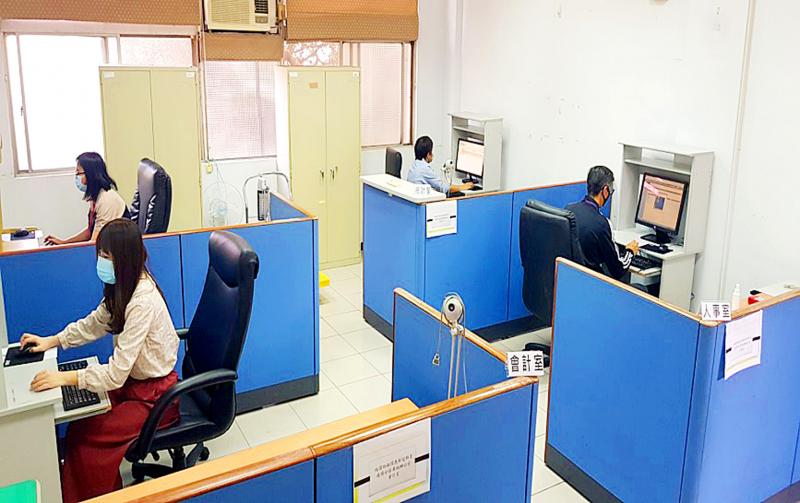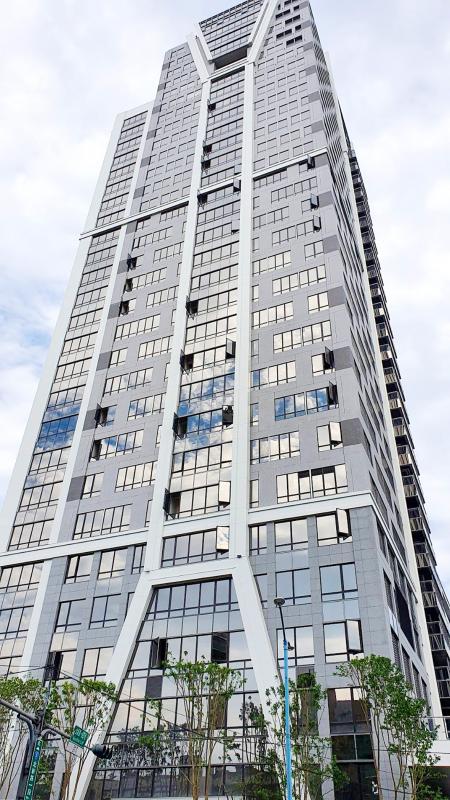Just over a year ago, David Pan (潘為), CEO of Gidea Group, moved to a smaller office, even though his team of creatives had grown larger than ever.
Pan, who founded the brand consultancy and design agency nearly 16 years ago, says that, for its first few years, all of his employees worked in the same office in central Tainan.
“But by the middle of last year, only about four of us, out of approximately 20 people, were regularly working in the office. Everyone else was working offsite, from home or a cafe,” he recalls.

Photo: Cheng Shu-ting, Taipei Times
Currently, just two employees are required to show up to the office at set times. One answers the phone and handles walk-in inquiries. The other is a new hire who’s being trained.
In North America, some enterprises encourage working from home (WFH) because it can save them a lot of money. In certain US cities, renting office space costs more than US$10,000 per employee per year.
Others go even further, and embrace distributed working so they can access a global talent pool. Among the few companies that have entirely distributed workforces, perhaps the best known is Automattic, the company behind WordPress; it has 1,200 employees in 77 countries, including two in Taiwan. Another is Chineasy, a language education company founded by Taipei-born, London-based Hsueh Shao-lan (薛曉嵐).

Photo: Chiu Shu-yu, Taipei Times
CLOCK-IN, CLOCK-OUT
Pan has different reasons for being enthusiastic about working from home.
“We’ve never calculated if we save money, or how much we might save, because we’ve never looked at it as an expense issue,” he says. “We want to produce the best possible work for our clients, and we want to retain our best people. It was in trying to solve that issue that I came to the realization that the traditional ‘clock-in, clock-out’ system wasn’t working.”
Typical working practices in Taiwan, he explains, “aren’t suitable for creative work, for knowledge work. Why? Some people are at their best in the middle of the night.”
“Working 9-to-5 is especially hard on many creatives. If they’re forced to be in the office those hours, but they’re not effective, they’ll end up doing overtime when they go home. That isn’t good for them or the company. So why make them come in at those times? It makes no sense,” Pan continues, pointing out that his best work is often done between 10pm and 1am.
Pan says that allowing staff to work from home helps Gidea attract and retain talented individuals.
“For us it does. It’s a competitive edge. Some members of our team left highly-paid jobs at well-known companies because they wanted a lifestyle change, usually because they have kids and they want to be more present at home.”
The Gidea boss hasn’t noticed any meaningful shift in favor of WFH or distributed working.
“Taiwanese bosses are still very set in their ways. Even in creative industries, very few companies do what we do,” says Pan, who spent much of his childhood in Canada. “Many people have told me this often happens in Taiwan: You’ve finished your work, it’s the end of the day, but because everyone’s still there, you can’t just get up and leave. If you do, you’ll be seen as a less-than-dedicated worker.”
Before COVID-19, Pan would see most of his employees — except for three based abroad — two or three times a week. Due to the outbreak, he’s also cut down on traveling to clients.
“More clients are now saying, ‘Let’s just do it online.’”
Pan scoffs at the idea that a person might prefer working in an office to staying at home, but one of the best-known studies identified two reasons why some employees turn down working from home options.
In 2010-11, a team led by Nicholas Bloom of Stanford University had 131 employees of a travel agency in Shanghai work from home for nine months. The control group consisted of 118 co-workers who continued commuting to the office five days a week. All 249 had volunteered to work from home. In the January 2015 issue of Harvard Business Review, Bloom wrote that, at the end of the experiment, “half of the home-workers changed their minds and returned to the office and three quarters of the control group — who had initially all requested to work from home — decided to stay in the office, as well. The main reason seems to be that people who worked from home were lonely.”
In a 2013 working paper for the National Bureau of Economic Research, Bloom pointed out that, for the agency’s employees, “WFH had a negative and weakly significant impact on promotion... WFH improved performance — increasing the probability of promotion — but this was offset by a roughly equal negative effect from being home based … supervisors did not notice [home-based employees’] performance as much and were less likely to promote them.”
INCENTIVES
Nonetheless, the Shanghai study presents compelling evidence in favor of working from home. The travel agency’s computerized records show that, in Bloom’s words, “the performance of the home-workers went up dramatically, increasing by 13 percent over the course of the nine months,” and that staff turnover fell “by almost 50 percent compared to the control group. The home-workers also reported substantially higher work satisfaction and less ‘work exhaustion.’”
Because working from home reduces traffic congestion and air pollution, incentivizing it could be part of a policy response to climate change. As Pan says, it gives adults more time with their families; in Taiwan, this could help bump up the birth rate. But beyond installing reasonably fast and inexpensive Internet, Taiwan’s government has done virtually nothing to encourage working from home.
“In general, the legal framework neither facilitates nor hinders WFH,” says Christine Chen (陳絲倩), a partner in Taipei-based law firm Winkler Partners. “One exception is that Taiwan has very strict rules about recording start and stop times to ensure employees are paid properly, especially for overtime. Businesses find ways to comply with these rules for employees working remotely, but they’re something of a hindrance because they may force the business to change the way it creates these records.”
OBSTACLES
Chen thinks that another possible hindrance is the law that working conditions can’t be changed to the employee’s detriment without the latter’s consent.
“However, I think few employees will see WFH as an adverse change,” she says. “In reality, the main obstacle to working from home is not the legal framework but rather Taiwanese business culture and employer attitudes. Almost all of my clients who’ve asked questions about WFH are foreign businesses. I think foreign companies are more open to employees working from home because they are concerned about liability issues arising from the pandemic. Also, they may already be doing this overseas.”
Culture perhaps explains why even tech companies have been surprisingly slow to embrace working from home.
Well before COVID-19, Acer Inc conducted remote working and working from home drills to optimize its IT infrastructure and conferencing systems, says a company spokesperson. Like Taiwan Semiconductor Manufacturing Co and some other enterprises, earlier this year Acer implemented a split-shift or “A/B” system which required office personnel to work from home every other day. But, according to the spokesperson, this only applies to a small portion of Acer’s Taiwan workforce, and the practice will end when the pandemic recedes.
Rather than allow work from home, some central and local government agencies have assigned part of their staff to off-site offices, so an infection cluster doesn’t close down an entire department.
For Jessie Yang (楊絜茹), the transition to working from home went smoothly, but she expects to be back in the office full-time when things return to normal.
Yang is employed by the Hong Kong branch of Glints, a Singaporean HR/career development company. She expected to return to Hong Kong after the Lunar New Year, but due to the outbreak she remained in Taiwan. For a while, she was going to the company’s Taipei office two or three days a week, and working remotely the rest of the time — an arrangement she liked.
When the situation got worse, Glints implemented a working from home policy for every employee. Yang, who now works from her parents’ home in Kaohsiung, says: “It wasn’t hard to get used to remote work. My team is based in Taiwan, Hong Kong, and Indonesia, so I’m quite used to remote communication. Before the coronavirus, I was communicating with my Indonesian and Taiwanese colleagues online.”
“It’s rather easy for a multinational company like ours to adopt a remote working strategy. For others, I believe it would take a lot of experimentation,” Yang says. But when COVID-19 ends, all Glints employees will return to their offices. Asked if she thinks that’s necessary for efficiency, she replies: “Not entirely… it also relates to team bonding, communication and morale.”

The Lee (李) family migrated to Taiwan in trickles many decades ago. Born in Myanmar, they are ethnically Chinese and their first language is Yunnanese, from China’s Yunnan Province. Today, they run a cozy little restaurant in Taipei’s student stomping ground, near National Taiwan University (NTU), serving up a daily pre-selected menu that pays homage to their blended Yunnan-Burmese heritage, where lemongrass and curry leaves sit beside century egg and pickled woodear mushrooms. Wu Yun (巫雲) is more akin to a family home that has set up tables and chairs and welcomed strangers to cozy up and share a meal

Dec. 8 to Dec. 14 Chang-Lee Te-ho (張李德和) had her father’s words etched into stone as her personal motto: “Even as a woman, you should master at least one art.” She went on to excel in seven — classical poetry, lyrical poetry, calligraphy, painting, music, chess and embroidery — and was also a respected educator, charity organizer and provincial assemblywoman. Among her many monikers was “Poetry Mother” (詩媽). While her father Lee Chao-yuan’s (李昭元) phrasing reflected the social norms of the 1890s, it was relatively progressive for the time. He personally taught Chang-Lee the Chinese classics until she entered public

Last week writer Wei Lingling (魏玲靈) unloaded a remarkably conventional pro-China column in the Wall Street Journal (“From Bush’s Rebuke to Trump’s Whisper: Navigating a Geopolitical Flashpoint,” Dec 2, 2025). Wei alleged that in a phone call, US President Donald Trump advised Japanese Prime Minister Sanae Takaichi not to provoke the People’s Republic of China (PRC) over Taiwan. Wei’s claim was categorically denied by Japanese government sources. Trump’s call to Takaichi, Wei said, was just like the moment in 2003 when former US president George Bush stood next to former Chinese premier Wen Jia-bao (溫家寶) and criticized former president Chen

President William Lai (賴清德) has proposed a NT$1.25 trillion (US$40 billion) special eight-year budget that intends to bolster Taiwan’s national defense, with a “T-Dome” plan to create “an unassailable Taiwan, safeguarded by innovation and technology” as its centerpiece. This is an interesting test for the Chinese Nationalist Party (KMT), and how they handle it will likely provide some answers as to where the party currently stands. Naturally, the Lai administration and his Democratic Progressive Party (DPP) are for it, as are the Americans. The Chinese Communist Party (CCP) is not. The interests and agendas of those three are clear, but